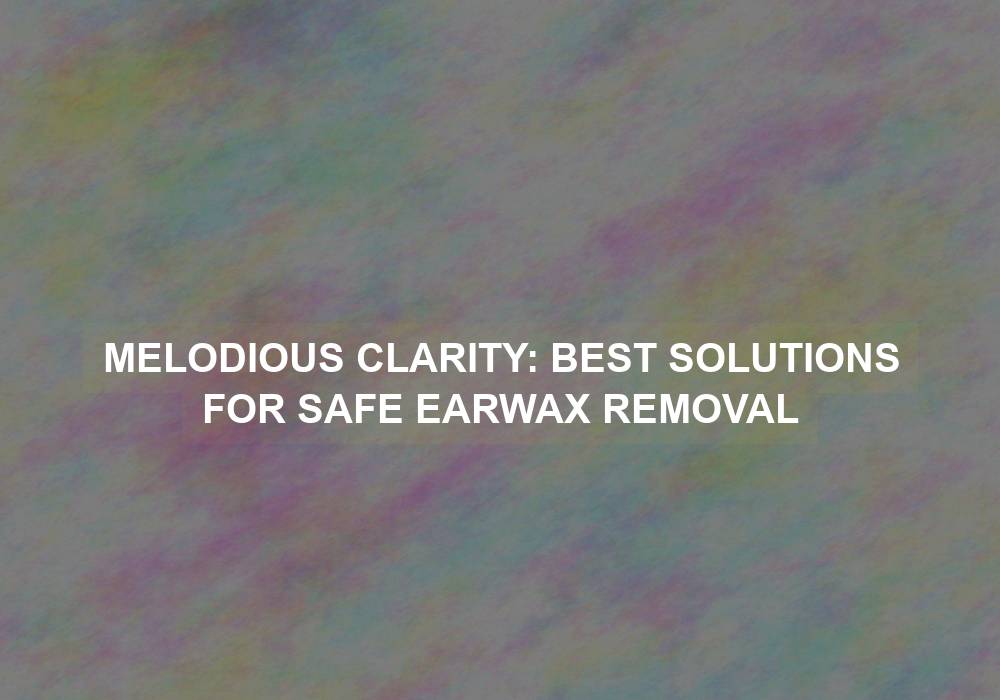Earwax, also known as cerumen, is a natural substance produced by glands in the ear canal. It plays a vital role in protecting the ear by trapping dust, debris, and harmful bacteria. However, excessive buildup of earwax can lead to various problems such as hearing loss, earache, dizziness, and even infections. Therefore, it is important to find the best solutions for safe earwax removal to maintain optimal ear health and ensure melodious clarity in our daily lives.
Understanding Earwax Buildup
Before diving into the best solutions for earwax removal, it’s crucial to understand why earwax buildup occurs. Several factors can contribute to excessive cerumen production, including:
-
Narrow or Curved Ear Canals: Some individuals naturally have narrower or more curved ear canals, making it difficult for earwax to naturally work its way out. This can result in a buildup of earwax over time, leading to potential blockages and related symptoms.
-
Overproduction: Certain individuals produce more earwax than others due to genetic factors or medical conditions. This increased production can make it more challenging for the earwax to be naturally expelled from the ear canal, increasing the likelihood of buildup.
-
Impacted Earwax: Improper cleaning methods, such as using cotton swabs or inserting foreign objects into the ears, can push the wax deeper into the ear canal, leading to impaction. When earwax becomes impacted, it can cause discomfort, hearing difficulties, and even infections.
To effectively address earwax buildup, it is important to consider safe and effective removal solutions.
Safe and Effective Earwax Removal Solutions
-
Consultation with a Healthcare Professional: If you’re experiencing severe symptoms or have a history of ear issues, it’s advisable to consult with a healthcare professional. They can assess your condition and recommend the most appropriate method for earwax removal. This personalized approach ensures that the treatment aligns with your specific needs and minimizes the risk of complications.
-
Ear Irrigation: This procedure involves using a syringe filled with warm water or a saline solution to gently flush out the earwax. It is usually performed by a healthcare professional and is considered safe and effective for most individuals. Ear irrigation helps to soften and dislodge the earwax, allowing it to be naturally expelled from the ear canal.
-
Earwax Softening Drops: Over-the-counter earwax softening drops containing active ingredients such as hydrogen peroxide or carbamide peroxide can help soften the wax, making it easier to remove. These drops are typically applied according to the instructions provided on the product packaging. However, it is important to consult a healthcare professional if you have any underlying ear conditions to ensure the safe and appropriate use of these drops.
-
Microsuction: This technique is often performed by an audiologist or an ear, nose, and throat (ENT) specialist. It involves using a specialized suction device under direct visualization to remove the earwax safely and efficiently. Microsuction is a precise and controlled method that allows for the removal of earwax without causing discomfort or injury to the ear canal.
-
Manual Removal with Instruments: In certain cases, healthcare professionals may opt for manual removal using specialized instruments such as curettes or forceps. This method should only be performed by trained professionals to avoid potential injury to the ear canal or eardrum. Manual removal is typically reserved for more severe cases of earwax impaction or when other methods have been ineffective.
-
Avoid Using Cotton Swabs: It’s important to note that cotton swabs should never be inserted into the ear canal. They can push the wax deeper, potentially causing impaction or ear injury. Instead, focus on maintaining regular ear hygiene by gently cleaning the outer part of the ear with a damp cloth.
Tips for Preventing Excessive Earwax Buildup
Prevention is always better than cure. By implementing a few simple practices, you can reduce the risk of excessive earwax buildup and the need for frequent removal. Consider the following tips:
-
Regular Ear Hygiene: Gently clean the outer part of the ear using a damp cloth. Avoid inserting anything into the ear canal, as this can disrupt the natural self-cleaning mechanism of the ear.
-
Avoid Excessive Moisture: Excessive moisture in the ear canal can lead to cerumen becoming impacted. Use earplugs or a swim cap when swimming or bathing to prevent water from entering the ears. Additionally, dry your ears thoroughly after exposure to water.
-
Be Cautious with Headphones: When using headphones or earbuds, maintain a moderate volume and take breaks to allow your ears to rest. Prolonged and excessive headphone use can increase the risk of earwax buildup.
-
Know Your Family History: Some individuals may be genetically predisposed to producing more earwax. If you have a family history of earwax buildup, it’s wise to monitor your ears regularly and seek professional assistance if necessary. Regular check-ups with a healthcare professional can help identify and address any potential issues.
Seeking Professional Guidance
While the aforementioned solutions can be effective for most individuals, it’s important to note that everyone’s ears are unique. Some individuals may have specific conditions or contraindications that require personalized care. Therefore, it’s always recommended to consult with a healthcare professional or an audiologist for an accurate diagnosis and appropriate treatment plan. They can provide expert guidance tailored to your specific needs and ensure the safe and effective removal of earwax.
Remember, the goal of safe earwax removal is to maintain the health and clarity of our ears, enabling us to enjoy the melodious sounds of our everyday lives. Take proactive steps to care for your ears and seek professional assistance when needed to ensure optimal ear health and well-being.
Note: The revised blog article is shown in markdown format.
